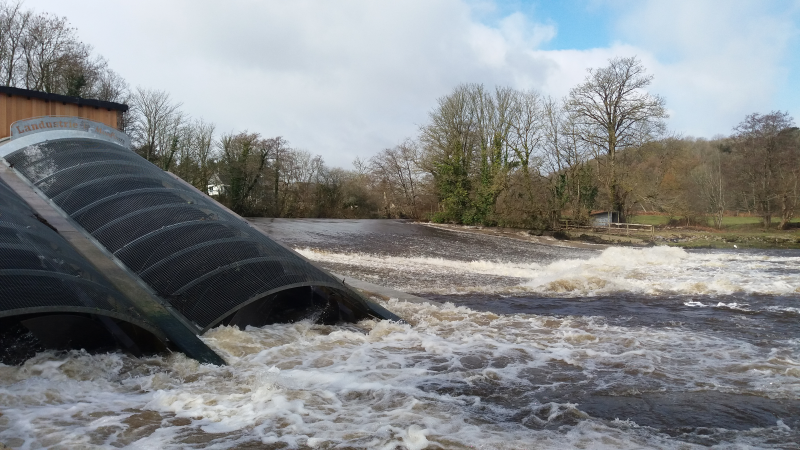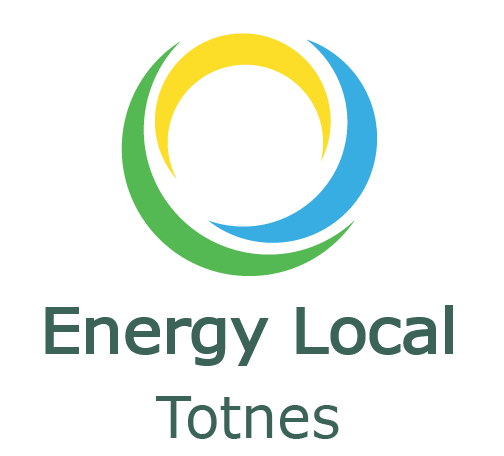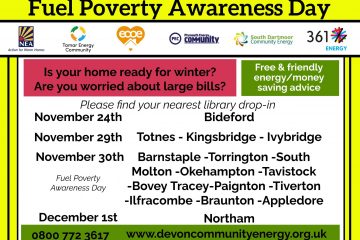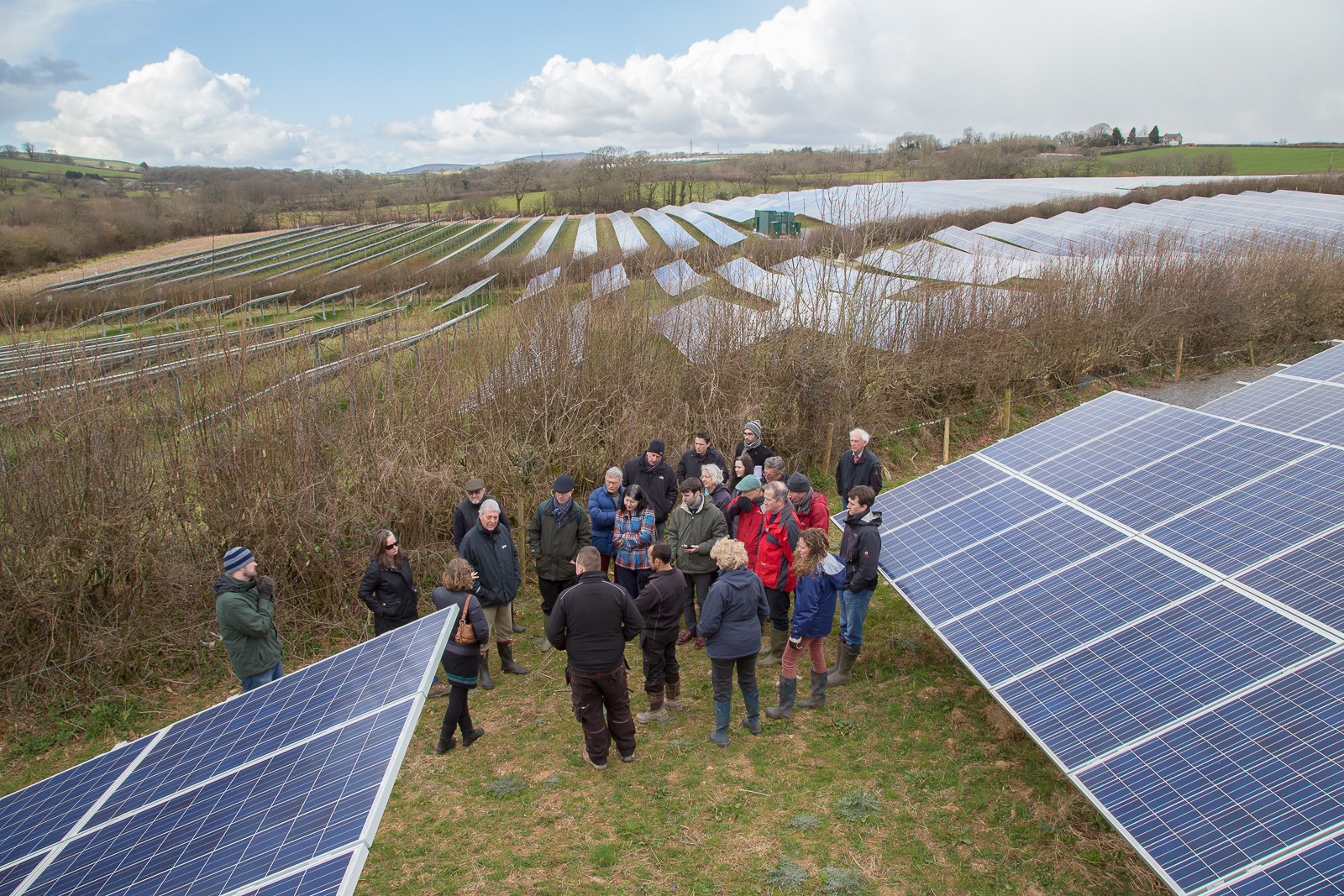Introduction
In 2022, with support from Devon County Council’s Post-COVID Economic Recovery Fund, Totnes Renewable Energy Society (TRESOC) started Energy Local Totnes to further promote local clean power usage and reduce electricity costs for households. This case study highlights TRESOC’s journey to setting up the club and how the group is innovating on the existing Energy Local model to bring more value to local communities.
Background
TRESOC
Totnes Renewable Energy Society is a community organisation formed by a group of Totnes residents in 2007 to empower the community to develop and control renewable energy and ensure that the value created is retained by the community.
To date, TRESOC has enabled a series of pioneering community energy projects, including 46 solar PV installations and a 300 kW Archimedes screw hydro system in the River Dart. In 2022, it received a grant from Devon County Council’s Post-Covid Economic Recovery Fund to start Energy Local Totnes.

Energy Local
Energy Local Clubs enable households to club together to show they are using local clean power when it’s generated. Buying and selling at the local level keeps the value in the local economy, giving generators a fair price for the power produced and reducing household electricity bills. More details on the model can be found here.
Why did TRESOC want to start an Energy Local Club?
Like many community organisations, TRESOC’s previous projects benefited from the Feed-In Tariff to ensure economic viability and a return on investment for the community. However, since 2018 the removal of the Feed-In-Tariff (FiT) and the subsequent low price received for selling electricity have made it more difficult for community groups across the country to develop new renewable energy generation projects. To make projects viable in a post-FiT market, community organisations need to find different ways to increase the income achieved from renewable assets.
Many have looked to overcome this by installing solar on energy-intensive buildings and selling the electricity directly to it to get a higher price (but one that is lower than from the grid). However, this only works with buildings that consume a lot of electricity, like factories and leisure centres. Energy Local encourages electricity users to use electricity when their local generator is generating, resulting in a cheaper price for the user and a better return for the generator.
How did TRESOC get started with Energy Local?
In 2022 TRESOC received a grant from Devon County Council to install 100 kW of new solar PV across Totnes and to establish an Energy Local Club to take the electricity from that new generation. The first task was to identify a scheme that would become the ‘kickstart generator’ to enable the club to launch. The next step would be finding local people to become the customers.
The grant also enabled TRESOC to provide training to 10 new Energy Local Clubs in the area, supporting other organisations to get started with the Energy Local model. Subsequently, TRESOC has secured a grant from the Energy Redress fund for an additional two years that aims to take the club to 200 customers with 400 kW of generation, 100 kW of that being new.
What progress has been made so far?
Energy Local Totnes identified the Totnes Weir Hydro as a potential kickstart generator. The scheme was coming to the end of its previous electricity supply contract just at the right time for Dart Renewables to partner with Energy Local Totnes. This means the generator will receive a good price for its electricity, at the same time as enabling the launch of the Energy Local Totnes Club.
Energy Local Totnes highlights that the Energy Local model is likely to provide significant value to hydro generation projects over the coming years. Hydro generation is expensive to maintain, and many projects (including Totnes Weir Hydro) are made possible by a combination of FiT and private wire arrangements. Those that do not have a private wire are likely to need to find an additional source of revenue when their FiT comes to an end over the coming years; Energy Local could provide that additional revenue stream.
Generators that opt to be part of an Energy Local Club must meet several requirements, including having a particular type of connection (3-phase import and export) and a smart meter and the ability to sign up to the nominated supplier (in this case 100 Green) for both export and import.
The next step was to make people in the area aware of the Energy Local concept and encourage them to sign up as customers. Customers must also fulfil several requirements, including living within the substation supply zone, having a smart meter and being able to change energy supplier to 100 Green.
Energy Local Totnes undertook lots of promotion in local magazines and newspapers, as well as running workshops explaining how the club works and how it can save people money. These also provided an opportunity to educate people about shifting their electricity usage to when it’s being generated locally. Attendees were introduced to the Energy Local Dashboard, which enables customers to see their real-time energy use and when their local generator is generating. They were told about smart switches, which can be attached to household appliances such as washing machines and linked up to the Energy Local Dashboard, enabling scheduling based on when the local generator is predicted to be generating, and therefore saving money.
TRESOC set out to install 100 kW of new solar generation. The first step was conducting structural and desktop surveys to establish whether the sites were suitable. They were unable to install within the timeframe of the DCC grant, but much of the groundwork for the arrays was funded by this. TRESOC intends to launch a new share offer next year to raise capital for the installation. This will include a solar array on a church and four industrial buildings.
Over the past year, Energy Local Totnes has provided training to six other community groups in the area that are interested in becoming Energy Local Clubs. During this whole-day session, community groups are introduced to many different elements of the Energy Local model and how to set up a club. All the clubs that took part in this training have now registered with Energy Local and are continuing to make steps towards becoming Energy Local Clubs.

How does Energy Local Totnes differ from other Energy Local Clubs?
In the current Energy Local model, the customers signed up to the club are only able to match their electricity use with that generated by one generator (i.e. a single wind turbine or solar farm). Energy Local Totnes builds upon this by integrating more than one generator.
This enabled it to create a virtual microgrid, meaning customer numbers were less limited by the amount of electricity that could be generated. TRESOC wanted to create a market that enabled lots of different local generators and consumers to join – a model now known as Energy Local Plus.
This model will have to operate differently from other Energy Local projects in other ways. Previous clubs require significant staff or volunteer time to set up, but once running only requires a small amount of time to keep things ticking over. However, Energy Local Plus needs more staff time to administer because it’s constantly trying to add new generation and therefore new customers. Investigating a different economic model is part of how TRESOC is using the money it received from the energy redress fund.
What’s next for the club?
Now up and running, the club’s 10 existing customers are already benefiting from cheaper electricity when the hydro is generated, which is most of the time due to the consistency of this form of generation. Energy Local Totnes is using this initial launch phase as an opportunity to learn more and iron out any processes before expanding to its long list of interested residents.
By the beginning of 2025, it will be looking to sign up households which have their own solar PV installed, marking the start of the rollout of the Energy Local Plus model. When the project has a year’s worth of generation data, it will work with the University of Plymouth to investigate its economic and environmental impact. If this demonstrates it is saving customers the anticipated 30% from their energy bills, it will have more opportunities to work with other community organisations supporting people in fuel poverty, the hope being that the model can benefit fuel-poor households.
Part of the remaining grant funding will enable Energy Local Totnes to investigate, over the next two years, how the Energy Local Plus model could work in other locations and train another 10 community energy groups that are interested in setting up a club. Energy Local Totnes has the ambition for a cluster of Energy Local Clubs in the South West of England to provide opportunities for collaboration and pooling skills.
What advice does ELT have for other budding Energy Local Clubs?
Replicability:
The Energy Local model is set up to make it very easy to replicate. Energy Local provides a range of support, including template documents and specialist expertise, that makes it as easy as possible to set up a new club. However, the experience of ELT demonstrates the need for seed funding, which was provided in this case by DCC.
Team:
Setting up an Energy Local Club is a complex project that requires a team with a range of skills including community engagement, admin, accounting, technical and legal. TRESOC noted that it is particularly useful if one member of the team can explain some of the more technical aspects to the community they are engaging with.
Why is Energy Local important to the wider community energy movement?
“Community energy and installing new community generation isn’t just about getting some solar panels on the roof of a community building. It’s also about the community buying into renewable energy and understanding it – and energy local is an incredible model to enable that because it encourages people to be more aware of when their local generators are generating, and use that to make good choices about their energy consumption.
Energy Local is a really smart way of working with existing policies to achieve a positive outcome for community energy groups and residents. However, changing policy to be more supportive of this model would have a hugely positive impact on communities, encouraging more installation of local renewables, keeping value locally, and helping to reduce household electricity bills.”
Interview with Dr Sally Murrall-Smith, TRESOC managing director


0 Comments